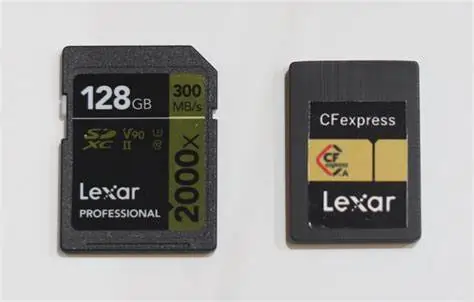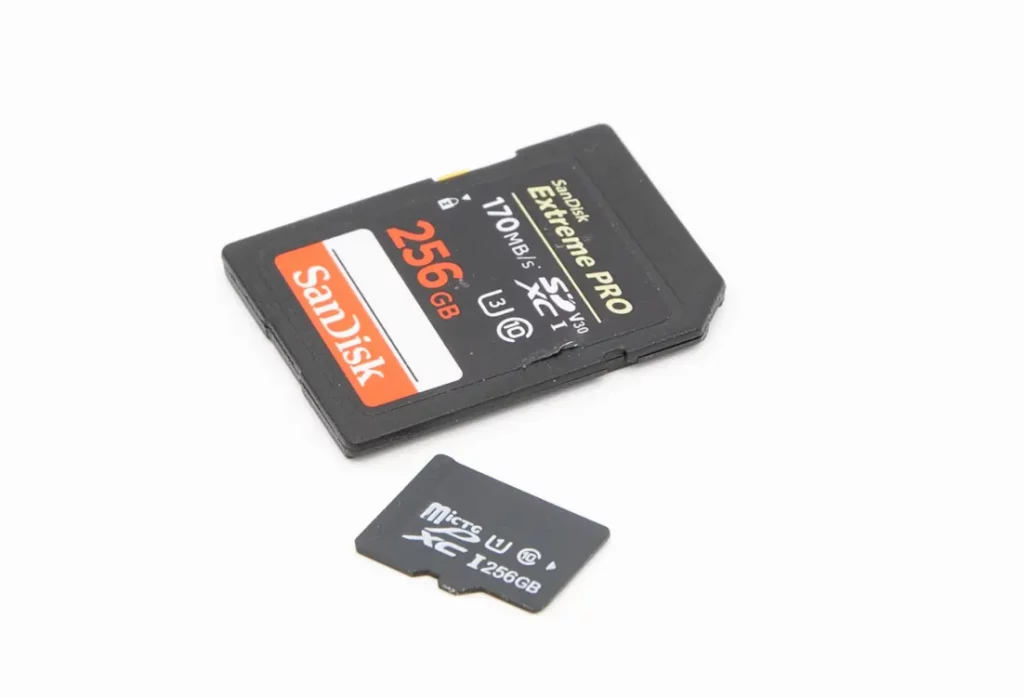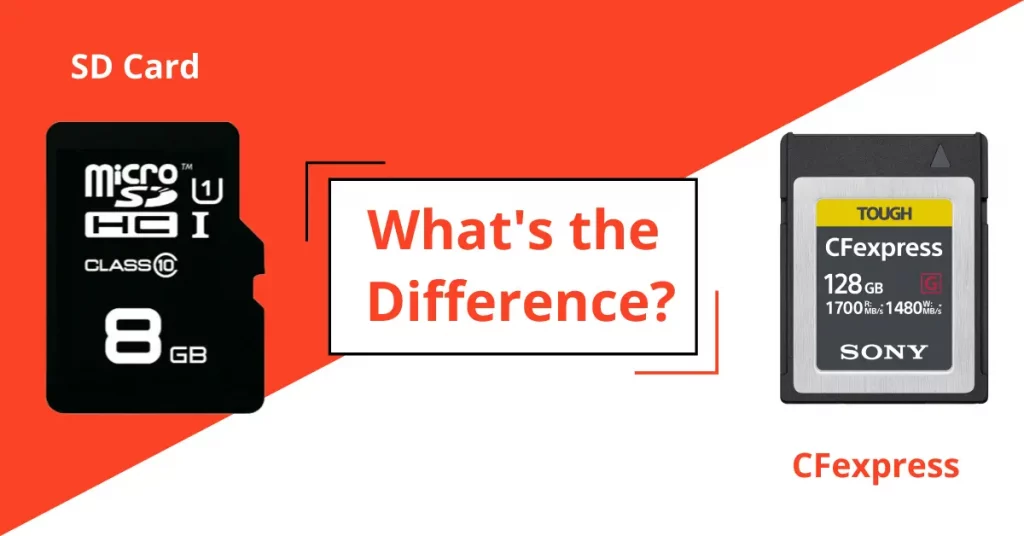In the ever-evolving world of digital photography, videography, and data storage, the choice of memory cards plays a crucial role in ensuring the efficiency and reliability of your equipment. Among the numerous options available, two contenders stand out: CFexpress and SD cards. In this blog post, we will delve into the world of these memory cards, exploring their features, advantages, disadvantages, and the battle between CFexpress and SD cards for dominance in the storage arena.
Advantages of CFexpress Cards
CFexpress, short for Compact Flash Express, is a relatively recent addition to the world of memory cards. These cards were designed to bridge the gap between existing storage solutions like SD cards and more specialized formats like CF cards and XQD cards.
Lightning-Fast Write Speeds
CFexpress memory cards are renowned for their blazing-fast write speeds. Using the PCIe 3.0 interface, they can achieve data transfer speeds that far surpass their predecessors, making them an excellent choice for professional photographers and videographers who require rapid data storage.
Robust Build Quality
CFexpress cards are known for their durability. Built to withstand challenging conditions, they are often designed to be shockproof and waterproof, ensuring your valuable data remains intact even in adverse environments.

Firmware Updates
CFexpress cards allow for firmware updates, which can improve compatibility and performance over time. This feature ensures that your investment in CFexpress technology remains relevant to evolving hardware and software requirements.
Disadvantages of CFexpress Cards:
Higher Costs
The superior performance and build quality of CFexpress cards come at a price. They are generally more expensive than their SD counterparts. However, the investment may be justified for professionals who require top-tier performance and reliability.
Limited Compatibility
As a relatively new technology, CFexpress cards may not be compatible with all devices. Users may need to purchase card readers and adapters to access their data on older equipment.
What is an SD Card?
SD cards, or Secure Digital cards, are one of the most widely used forms of memory storage in the consumer electronics industry. They come in various sizes, including standard, micro, and mini-SD cards, making them compatible with a wide range of devices.
Advantages of SD Cards
Universality
One of SD cards’ greatest strengths is their universal compatibility. Nearly all modern digital cameras, camcorders, smartphones, and laptops include SD card slots, making these cards incredibly versatile.
Cost-Effectiveness
SD cards are known for their affordability. They offer a cost-effective solution for users who need ample storage without breaking the bank.
Dual Card Slots
Many high-end cameras and camcorders are equipped with dual card slots, allowing users to simultaneously record data on two SD cards. This redundancy can be a lifesaver in critical situations, providing a backup in case one card fails.
Disadvantages of SD Cards
Write Speed Limitations
While SD cards come in various speed classes, their write speeds generally lag behind those of CFexpress cards. This can be a significant drawback for professional photographers and videographers working with large, high-resolution files.
Limited Lifespan
SD cards may have a limited lifespan compared to CFexpress cards due to their lower durability. Frequent read/write cycles can lead to wear and tear, potentially resulting in data loss over time.

CFexpress vs. SD Card: The Showdown
Now that we have explored the key features and advantages of both CFexpress and SD cards let’s pit them against each other in a head-to-head comparison.
Write Speed
- CFexpress: With their PCIe 3.0 interface, CFexpress cards offer unmatched write speeds, making them the go-to choice for professionals working with high-resolution images and 4K+ video.
- SD Card: While SD cards come in different speed classes, even the fastest ones can’t match the write speed capabilities of CFexpress cards.
Price
- CFexpress: CFexpress cards are more expensive than SD cards, which might deter budget-conscious consumers. However, professionals often consider the investment worthwhile for the performance gains.
- SD Card: SD cards are more budget-friendly, making them a popular choice for everyday users.
Compatibility
- CFexpress: Being a newer technology, CFexpress cards may require adapters or card readers for compatibility with older devices.
- SD Card: SD cards enjoy widespread compatibility across various devices thanks to their long-standing presence in the market.
Durability
- CFexpress: CFexpress cards are designed to withstand challenging conditions, making them a reliable choice for outdoor and rugged use.
- SD Card: While some SD cards offer decent durability, they may not be as robust as CFexpress cards.
Form Factor
- CFexpress: CFexpress cards come in Type A and Type B form factors, allowing users to choose the size that suits their devices.
- SD Card: SD cards are available in various sizes, including standard, micro, and mini, offering versatility in device compatibility.
Transfer Speed
- CFexpress: CFexpress cards boast exceptional transfer speeds, ideal for quickly offloading large media files to a computer.
- SD Card: While SD cards have varying speed classes, they generally have lower transfer speeds compared to CFexpress cards.
In the battle of CFexpress vs. SD cards, the choice ultimately depends on your specific needs and budget. CFexpress cards excel in performance and durability, making them the preferred choice for professionals who demand top-tier storage solutions. On the other hand, SD cards offer cost-effective versatility and universal compatibility, making them an ideal option for casual users and those who prioritize budget-friendly solutions.
Before making your decision, consider the demands of your work and the compatibility of your devices. If you require lightning-fast write speeds and can invest in the technology, CFexpress cards may be the way to go. However, if you value affordability, widespread compatibility, and the peace of mind that comes with dual card slots, SD cards are likely the better choice.
In the ever-evolving landscape of memory cards, both CFexpress and SD cards have their places, ensuring that you can find the perfect solution for your unique storage needs. As technology continues to advance, it is worth keeping an eye on the developments in memory card technology to stay ahead in your field and make the most of your valuable digital content.
Frequently Asked Questions
What are the main differences between CFexpress and SD cards?
CFexpress cards are known for their high-speed performance, utilizing the PCIe 3.0 interface, while SD cards offer various speeds and capacities, often with slower write speeds. CFexpress cards also come in two form factors: Type B and Type A, whereas SD cards have multiple form factors and classes.
Why should I choose CFexpress over SD cards?
CFexpress cards are the preferred choice for professional photographers and videographers who require lightning-fast write speeds for 4K/8K video recording and high-resolution image capture. They are also suitable for use in cameras with dual card slots, providing redundancy and extended storage.
Are CFexpress cards compatible with my existing camera or device?
CFexpress cards are becoming more common in high-end cameras, but their compatibility may require a firmware update in some older models. It is essential to check your camera’s specifications and manufacturer recommendations before making the switch.
When should I use SD cards instead of CFexpress?
SD cards are a versatile choice for casual photographers, amateurs, and users of various electronic devices. If you have a consumer-grade camera or don’t require the blazing-fast speeds of CFexpress, SD cards can be a cost-effective and convenient option.
